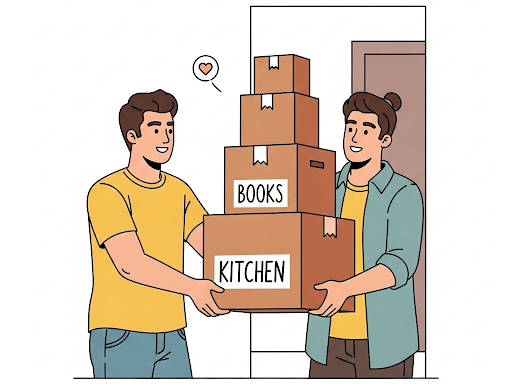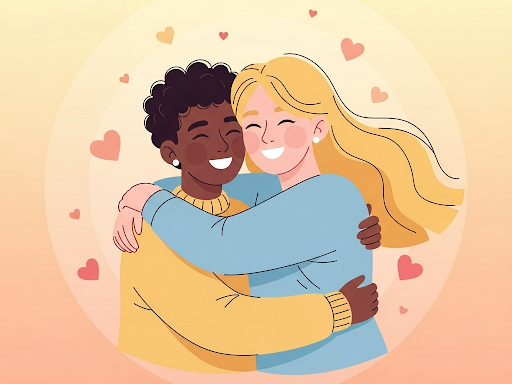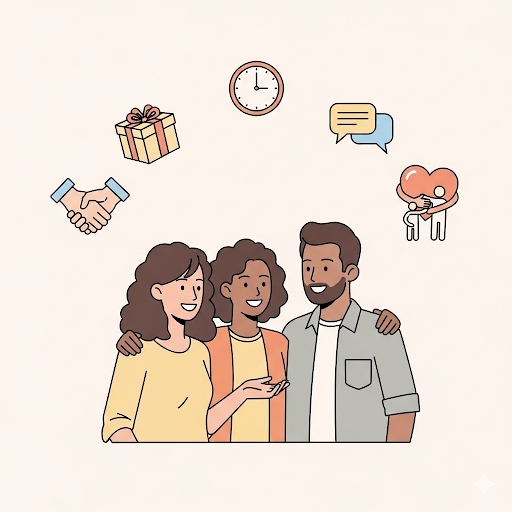Love Languages in Friendships: How to Strengthen Platonic Bonds

Love Languages in Friendships (2025)
When people think about love languages, they usually imagine romantic partners. But love isn’t limited to couples — it’s just as important in friendships. Understanding how your friends feel valued can deepen trust, prevent misunderstandings, and create lasting bonds.
This guide explores how the five love languages show up in friendships, why they matter, and how you can use them to build stronger, more fulfilling platonic relationships.
Why Love Languages Matter in Friendships
Friendships thrive on connection, but everyone experiences connection differently. Some friends feel closest when you’re spending quality time together. Others light up when you give small, thoughtful gifts.
When love languages go unnoticed, mismatched expectations can cause distance:
- One friend keeps planning hangouts (Quality Time), while the other expresses care by sending encouraging texts (Words of Affirmation).
- Both care deeply, but they may feel unappreciated if they don’t recognize each other’s language.
Learning your friends’ love languages bridges that gap, ensuring everyone feels seen.
The 5 Love Languages in Friendships
Let’s break down how each love language applies outside of romance.
1. Words of Affirmation

- Compliments, encouragement, or simply expressing gratitude go a long way.
- Examples in friendships:
- Sending a “thinking of you” text before a big exam.
- Telling your friend, “I really appreciate how you always listen.”
- Writing a supportive birthday message.
- Pitfall to avoid: Don’t assume occasional praise is enough — consistency matters.
2. Quality Time

- This friend values your undivided attention.
- Examples:
- Grabbing coffee and catching up without distractions.
- Planning regular “friendship dates.”
- Spending a weekend together, even if just watching movies.
- Pitfall to avoid: Being physically present but emotionally absent (scrolling your phone while hanging out).
3. Acts of Service

- Actions speak louder than words here.
- Examples:
- Helping a friend move into their new apartment.
- Bringing them soup when they’re sick.
- Proofreading their resume before a job application.
- Pitfall to avoid: Only showing up when it’s convenient. Consistency proves reliability.
4. Receiving Gifts

- It’s not about materialism — it’s about thoughtfulness.
- Examples:
- Picking up their favorite snack when you stop by.
- Giving a small memento after a trip.
- Surprising them with a handwritten note or inside joke.
- Pitfall to avoid: Buying expensive gifts without meaning. For this love language, thought > cost.
5. Physical Touch

- Less common in friendships, but still powerful when comfortable and culturally appropriate.
- Examples:
- Hugs when greeting or saying goodbye.
- A supportive pat on the back after good news.
- Linking arms or playful high-fives.
- Pitfall to avoid: Misreading comfort levels. Always respect boundaries.
How to Discover Your Friend’s Love Language
Not every friend will know their love language off the top of their head. Here are ways to figure it out:
- Observe patterns: Do they light up when you invite them out? Do they keep small gifts you’ve given?
- Ask directly: “What makes you feel most cared for in friendships?”
- Experiment: Try different approaches and see what resonates most.
- Take the quiz together: The official Love Languages quiz isn’t just for couples — friends can benefit too.
Benefits of Applying Love Languages to Friendships
When you align with your friends’ love languages, you:
- Reduce miscommunication and unmet expectations.
- Strengthen loyalty and emotional connection.
- Create a safe space where both people feel valued.
- Deepen bonds during both good times and hard times.
Friendships often drift when effort feels one-sided. Knowing each other’s languages makes that effort meaningful.
Real-Life Examples of Love Languages in Friendships
- College friends: A group might prioritize late-night hangouts (Quality Time), while one person feels left out unless they get explicit appreciation (Words of Affirmation).
- Long-distance friendships: Sending care packages (Receiving Gifts) or scheduling video calls (Quality Time) helps maintain connection.
- Workplace friendships: Helping with a project (Acts of Service) or celebrating small wins (Words of Affirmation) fosters camaraderie.
Common Challenges & How to Overcome Them
1. Mismatched Love Languages
Friends may naturally express love differently. The key is recognizing intention, even when expression doesn’t match preference.
Example: Your friend always buys you little gifts, but what you really want is more time together. Instead of feeling unloved, acknowledge the gesture and gently express what matters most to you.
2. Cultural or Personal Comfort Levels
Not every culture or individual is comfortable with physical touch in friendships. Respect boundaries and lean into languages that feel safe.
3. Avoiding Scorekeeping
Don’t treat love languages as transactions. The goal is connection, not balance sheets. If one person is more expressive, it doesn’t mean the friendship is unequal.
How to Apply Love Languages in Friend Groups
Love languages aren’t only for one-on-one friendships — they work in groups too.
- Words of Affirmation: Group shout-outs or appreciation posts.
- Quality Time: Group trips or game nights.
- Acts of Service: Organizing rides, bringing extra snacks, helping coordinate events.
- Receiving Gifts: Splitting the cost of a meaningful birthday gift.
- Physical Touch: Hugs or celebratory high-fives at group events.
The more aware a group is, the stronger the collective bond.
FAQs About Love Languages in Friendships
Can you have a different love language for friends than for partners?
Yes. Many people express and receive love differently depending on context. For example, someone may crave Words of Affirmation in romance but value Quality Time most with friends.
What if my friend doesn’t know their love language?
That’s okay. Pay attention to how they show love — people often give what they most want to receive.
Is it weird to talk about love languages with friends?
Not at all. Framing it as “ways we feel appreciated” makes the conversation natural.
Final Thoughts
Friendships deserve as much intentional care as romantic relationships. By understanding how your friends feel most valued, you can avoid misunderstandings, show up meaningfully, and create bonds that last a lifetime.
Whether it’s a text of encouragement, a thoughtful gesture, or simply sitting together without distractions, love languages give you a blueprint for stronger, healthier friendships.
Love isn’t only romantic. It’s in the ways we show up for each other, day after day — and when you learn your friends’ love languages, you’re showing up in exactly the way they need.


Leave a Reply